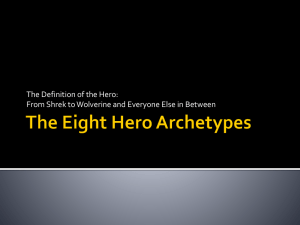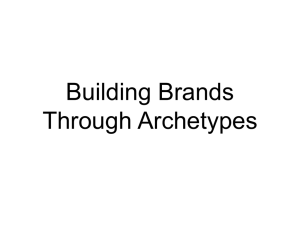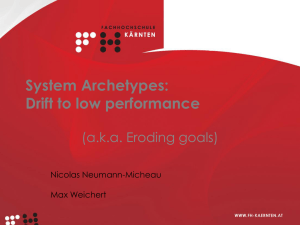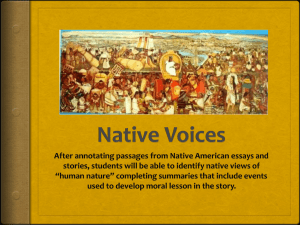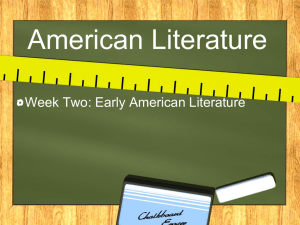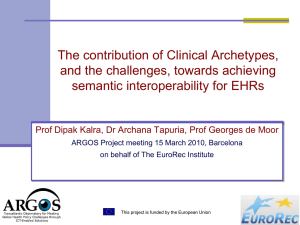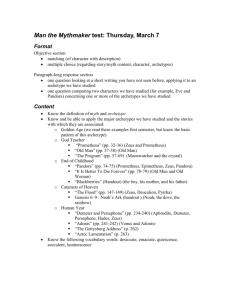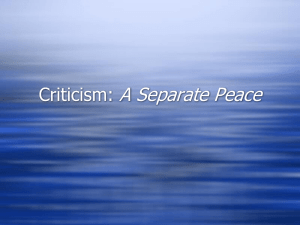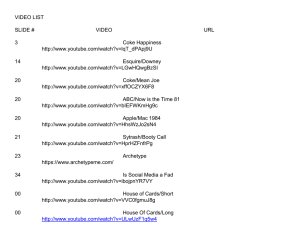David_Moner_LinkEHR
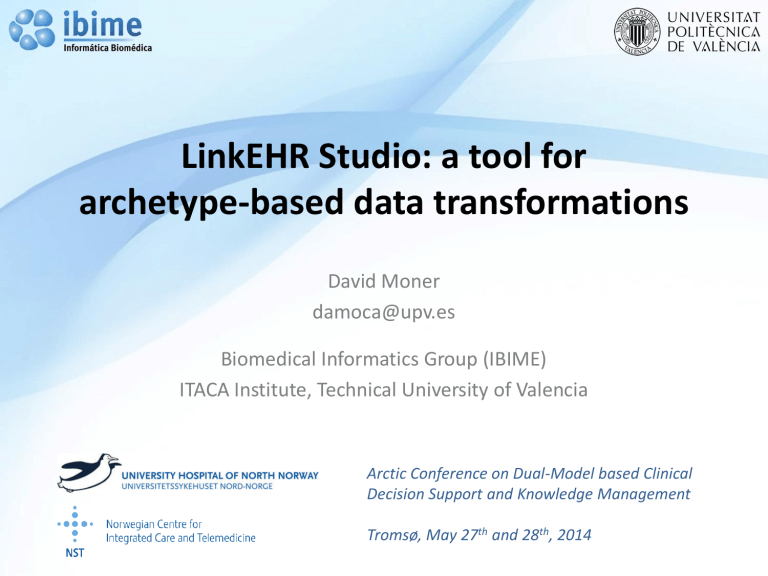
LinkEHR Studio: a tool for archetype-based data transformations
David Moner damoca@upv.es
Biomedical Informatics Group (IBIME)
ITACA Institute, Technical University of Valencia
Arctic Conference on Dual-Model based Clinical
Decision Support and Knowledge Management
Tromsø, May 27 th and 28 th , 2014
Model and data transformations
• Transformations are a key element for the communication and reuse of clinical information.
– Mainly for clinical research, but other uses are also possible.
2
3
Model and data transformations
Model and data transformations
• Two types of transformations are needed to achieve a full semantic interoperability :
Model transformations
• Consists in transforming clinical information models or clinical patterns into archetypes, DCM, templates…
• The objective is to ease the reuse of clinical information models
Data transformations
• Consists in transforming data instances from one format to another
• The objective is to ease the reuse of data
4
Model transformations
• Option 1: Direct transformation through ontologies and model-driven engineering
– http://miuras.inf.um.es:9080/PoseacleConverter/
– Martínez-Costa C, et al., “An approach for the semantic interoperability of ISO EN 13606 and OpenEHR archetypes”, J Biomed Inform, 43(5)(2010) pp.736-746
• Option 2: Automatic generation from common, shared and generic clinical information models
– This is the CIMI approach
– http://informatics.mayo.edu/CIMI/index.php/Main_Page
5
Data transformations
• We can have models defined for several standards, more or less aligned or equivalent.
• We can have data following those models, but also not normalized or legacy data.
• Can we make data interoperable ?
Yes, defining one-to-one mappings between different clinical information models for enabling data transformations
6
7
Single level mapping
Source schema
Instance of
Legacy data
Generates
Mapping
Transform script
Target schema
Instance of
Standard data
Single level mapping
• There is a direct relationship between the instances and their schemas
– It is “only” a matter of assigning a source path to a target path (maybe with some data operations).
$SOURCE/temperature $TARGET/temperature
– There are lots of tools for doing this…
8
Two level mapping
• When we use a dual-model it becomes more complicated
– The archetype defines a sub-schema that must be used during the mapping process.
– We can generate an ad hoc schema, specific for each archetype, but this solution can potentially create maintenance and interoperability problems.
9
Two level mapping
• LinkEHR Studio is a Reference Modelindependent archetype tool.
– It can define archetypes based on EN ISO 13606, openEHR, HL7 CDA, HL7 FHIR, CDISC ODM…
– It is also a mapping and transformation-generator tool to convert existing data into archetype/RM compliant data.
www.linkehr.com
10
Two level mapping
• LinkEHR Studio mapping functionality allows using directly archetypes as source or target schema .
– It is a tool for EHR systems developers.
• It generates an XQuery transformation program that can be used by any system that needs a conversion to/from archetyped data.
– It works with XML data.
11
12
Two level mapping
Case 1
Source schema
(Legacy model)
Instance of Generates
Mapping
Legacy data
Transform script
Target archetype
Target schema
(Reference model)
Compliant with
Instance of
Standard data
Two level mapping
Case 1
• Transformation of legacy to RM instance according to an archetype definition.
• Main problems solved
– We have to map the archetype structure + the RM properties: we map a comprehensive archetype .
– We need a function library for transformations: we use the XQuery function library and functions to gain access to the archetype metadata and terminologies.
– We have to generate compliant data : the script checks all constraints of the archetype and the RM.
– Data integration : aggregate data pertaining to the same patient.
13
Two level mapping
Case 1
• DEMO: The good ol’ blood pressure example
14
Two level mapping
Case 1
This is also applicable to
HL7 CDA or even to the new FHIR model
DEMO: from legacy data to HL7 CDA
15
Two level mapping
Case 2
Source schema
(Reference model)
Instance of
Compliant with
Source archetype
Mapping
Generates
Target archetype
Target schema
(Reference model)
Compliant with
Instance of
Standard data
Transform script
Standard data
16
Two level mapping
Case 2
• Transformation of archetyped data according to an RM to an RM instance according to a
different archetype definition (of the same or different RM).
• Main problems solved
– Conversion of source archetype paths into RMinstance paths.
– Mapping of data scattered among multiple archetypes.
17
Two level mapping
Case 2
• DEMO: from openEHR blood pressure to
13606.
• DEMO: from openEHR problems to an HL7
CDA document.
• DEMO: from HL7 CDA consultation note to openEHR.
18
Integrating the transformation scripts in your systems
• The script generated by LinkEHR is standard
XQuery .
– It can be executed by any XQuery engine at any point of the information system where a normalization process is needed.
+ Archetypes
Health Information System
XQuery
Communication interface
External data format
19
Use cases
• Medication reconciliation between primary and
secondary care (Hospital de Fuenlabrada,
Madrid)
– Active medication information has been normalized to a EN ISO 13606 data structure. Primary and secondary care clinicians reach a consensus on the data structure.
– The final result was integrated into the hospital HIS
(Siemens SELENE).
– This project was received the 2009 National Health
System Quality Award , by the Spanish Ministry of
Health.
20
Use cases
21
Use cases
• Nephrology information communication
using HL7 CDA documents (Hospital Virgen del Rocío, Sevilla)
– We modeled and generated HL7 CDA documents to support the continuity of care of over 500 patients with chronic kidney disease .
– Seven HL7 CDA archetypes were designed.
– Normalization layer is built over the integration engine already available on the organization.
22
Use cases
23
Use cases
• Feeding of a contract research organization
(CRO) information system using CDISC ODM
– Data from a commercial EHR system was extracted and transformed to CDISC ODM.
– Data was anonymized during this process.
– Normalized data was consolidated in the CRO system for further processing.
24
Use cases
25
Archetypes as the kernel for data reuse and query
Reference model
Archetype
Original data
Guides transformations
Defines
Archetypebased repository
Guides queries
Research subset
26
Thank you for your attention!
Questions?
This presentation has been supported by a grant from Iceland,
Liechtenstein and Norway through the EEA Financial Mechanism.
Operated by Universidad Complutense de Madrid
